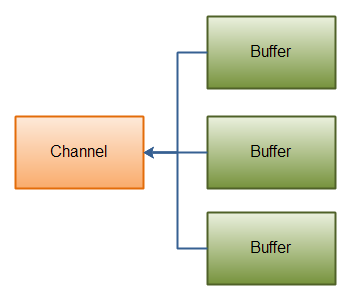Java NIO Scatter / Gather
2016-03-12 20:24
543 查看
Scattering Reads
Gathering Writes
Java NIO comes with built-in scatter / gather support. Scatter / gather are concepts used in reading from, and writing to channels.
A scattering read from a channel is a read operation that reads data into more than one buffer. Thus, the channel "scatters" the data from the channel into multiple buffers.
A gathering write to a channel is a write operation that writes data from more than one buffer into a single channel. Thus, the channel "gathers" the data from multiple buffers into one channel.
Scatter / gather can be really useful in situations where you need to work with various parts of the transmitted data separately. For instance, if a message consists of a header and a body, you might keep the header and body in separate buffers. Doing so may
make it easier for you to work with header and body separately.
A "scattering read" reads data from a single channel into multiple buffers. Here is an illustration of that principle:
Here is an illustration of the
Here is a code example that shows how to perform a scattering read:
Notice how the buffers are first inserted into an array, then the array passed as parameter to the
is full, the channel moves on to fill the next buffer.
The fact that scattering reads fill up one buffer before moving on to the next, means that it is not suited for dynamically sized message parts. In other words, if you have a header and a body, and the header is fixed size (e.g. 128 bytes), then a scattering
read works fine.
A "gathering write" writes data from multiple buffers into a single channel. Here is an illustration of that principle:
Here is a code example that shows how to perform a gathering write:
The array of buffers are passed into the
of 128 bytes, but only contains 58 bytes, only 58 bytes are written from that buffer to the channel. Thus, a gathering write works fine with dynamically sized message parts, in contrast to scattering reads.
Gathering Writes
| Jakob Jenkov Last update: 2015-09-02 |
A scattering read from a channel is a read operation that reads data into more than one buffer. Thus, the channel "scatters" the data from the channel into multiple buffers.
A gathering write to a channel is a write operation that writes data from more than one buffer into a single channel. Thus, the channel "gathers" the data from multiple buffers into one channel.
Scatter / gather can be really useful in situations where you need to work with various parts of the transmitted data separately. For instance, if a message consists of a header and a body, you might keep the header and body in separate buffers. Doing so may
make it easier for you to work with header and body separately.
Scattering Reads
A "scattering read" reads data from a single channel into multiple buffers. Here is an illustration of that principle:Here is an illustration of the
Scatterprinciple:
 |
| Java NIO: Scattering Read |
ByteBuffer header = ByteBuffer.allocate(128);
ByteBuffer body = ByteBuffer.allocate(1024);
ByteBuffer[] bufferArray = { header, body };
channel.read(bufferArray);Notice how the buffers are first inserted into an array, then the array passed as parameter to the
channel.read()method. The
read()method then writes data from the channel in the sequence the buffers occur in the array. Once a buffer
is full, the channel moves on to fill the next buffer.
The fact that scattering reads fill up one buffer before moving on to the next, means that it is not suited for dynamically sized message parts. In other words, if you have a header and a body, and the header is fixed size (e.g. 128 bytes), then a scattering
read works fine.
Gathering Writes
A "gathering write" writes data from multiple buffers into a single channel. Here is an illustration of that principle: |
| Java NIO: Gathering Write |
ByteBuffer header = ByteBuffer.allocate(128);
ByteBuffer body = ByteBuffer.allocate(1024);
//write data into buffers
ByteBuffer[] bufferArray = { header, body };
channel.write(bufferArray);The array of buffers are passed into the
write()method, which writes the content of the buffers in the sequence they are encountered in the array. Only the data between position and limit of the buffers is written. Thus, if a buffer has a capacity
of 128 bytes, but only contains 58 bytes, only 58 bytes are written from that buffer to the channel. Thus, a gathering write works fine with dynamically sized message parts, in contrast to scattering reads.
相关文章推荐
- 40个Java多线程问题总结
- 20145326《Java程序设计》第二周学习总结
- Java中的解析Xml
- Java多线程回顾1:线程的概念及创建
- Java集合源码学习笔记(二)ArrayList分析
- BIO | NIO | AIO (Java版)
- java入门学习(15)—多线程
- java判断“==”和equals的区别
- JAVA5多线程---Condition使用---线程通信 --wait及notify方法
- Java 消息服务(JMS)
- Java NIO Channel
- java selenium (六) XPath 定位
- java selenium (十四) 处理Iframe 中的元素
- java selenium (十三) 智能等待页面加载完成
- java selenium (十二) 操作弹出窗口
- java selenium (十一) 操作弹出对话框
- java selenium (十) 操作浏览器
- ubuntu软件安装五 eclipse和配置pydev
- java selenium (八) Selenium IDE 用法
- java selenium (五) 元素定位大全
